From all indications John Spofford sailed in 1638 from Hull, Yorkshire to Boston on the ship, "John of London." He was one of a group consisting of about 60 families led by the Rev. Ezekiel Rogers, most of whom had been residents of the Yorkshire village of Rowley and it's surrounding area.
Some Background:
For the past couple of years I've been attempting to find out more about this ship, "John of London." Unfortunately, there is little directly related historical information about the ship, let alone about the specific voyage in 1638 that carried this group to their new home in New England. Undoubtedly, Rev. Rogers kept records and a log during the voyage, but these, along with most of his belongings, were lost in the fire that destroyed his dwelling in Rowley, Mass. a few years after he and many of the group settled there. However, I have, thanks to several kind and generous researchers in the UK, been able to come up with a few specific bits of information about the ship. Much of what follows, however, is a result of conjecture based on ships, in general, of the early and mid 17th century.
Until shortly before the group left Yorkshire, the Rev. Rogers was vicar of St. Peter's church in Rowley for many years. Following the voyage to New England, he and many others in the group founded (in 1639) and settled in the village of Rowley, Mass., named after his previous English residence. In 1994 the people of Rowley, Mass. gave to the church of St. Peter's in Rowley Yks. a stained glass window to honor the memory of their founder. This window depicts Rev. Rogers, several of the settlers and the ship upon which they sailed. (1)
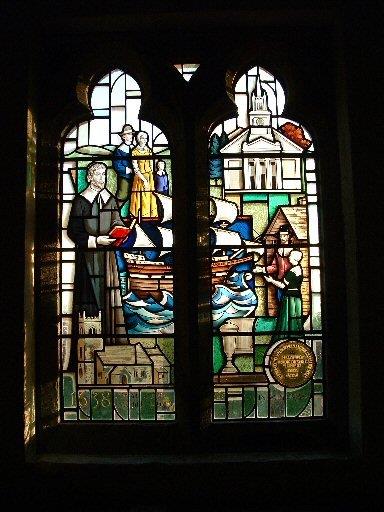
See http://http://www.littleweighton.org.uk/index.asp for more on Rowley, Yks.
The Galleon:
While the window depicts only a representation of the actual ship, most likely the "John of London" was a galleon or bark, the most common type of ship used by Europeans for ocean and long voyages during the latter part of the 16th century through the late 18th century. Varying considerably in size (120 tons to over 300 tons), these ships were commonly used for both commerce and warfare -- it was not unusual for the same ship to be refitted several times inorder to perform both roles throughout its life.
The Galleon is the ship that most people think of in connection with the Elizabethan period. A galleon and bark were very similar in design and appearance, differing mainly in the rigging of the mizzen (aftermost mast/sail) (2). The galleon was square rigged and characterized by its being relatively long, low and narrow (making it quite maneuverable), with a square tuck stern, and by having a snout or head projecting forward from the bow below the level of the forecastle. A galleon was powered entirely by sail, carried on three to five masts. Galleons were constructed from oak (for the keel), pine (for the masts) and various hardwoods for hull and decking. Many ships of this style had a 'gallery', or balcony, (See the pictures of "Susan Constant" and the model below.) around the stern and below the aftcastle, used originally to aid in rigging the ship, later sometimes covered and used as officer's toilets and/or quarters. Even when used only for commerce, the ship was generally armed with a sufficient number of cannons with which to defend itself against pirates and privateers.(3)
For illustrative purposes, following are several pictures of typical ships of the galleon/bark design:
A 1989 reproduction of the "Susan Constant" that carried 71 colonists to Jamestown, Virginia in 1607. A 55 Ft. Bark of about 120 tons: (4)
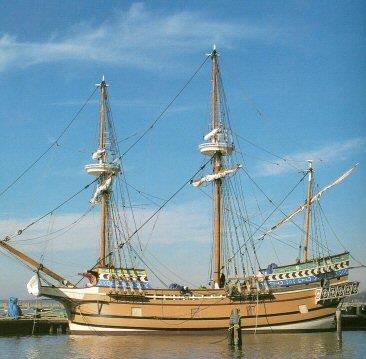
Line Drawing of the "Susan Constant": (4)
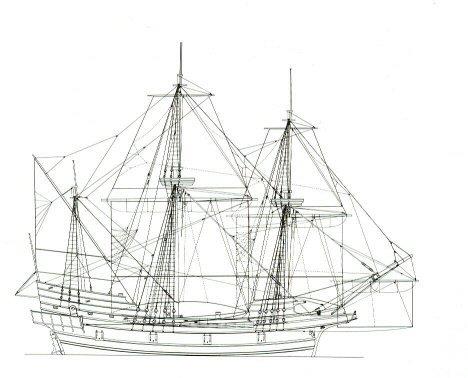
A Reproduction of the "Mayflower" that carried 101 Pilgrims to Plymouth Rock in 1620.
A 180 ton
Galleon measuring 90'(length) X 26'(width) X 11' (depth of hold): (5)
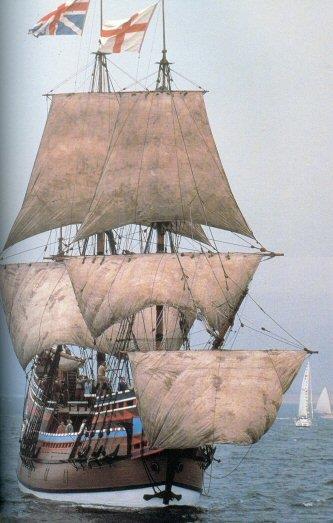
A model of typical galleon:

The John of London:
The ship "John of London" was very likely built by Robert Tranckmore(Tranekmore) in his shipbuilding yards at Shoreham-By-Sea on the southern coast of England. Tranckmore was building ships at least by 1619, possibly earlier. Three individuals currently researching in Yorkshire have indicated to me that they feel strongly that the "John of London" was built by Trankmore. Also, Henry Cheal writes the following:
"It was the usual custom at this period for a vessel, on her completion, to be furnished with as many pieces of ordnance as her owner deemed necessary for her defence, and for this purpose, warrants, known as Trinity House Certificates, were issued. They are known to have been granted in respect of the following ships, built by Tranekmore at Shoreham. Five of them were of 300 tons-a fair size for those days-four of 200, and one each of 180, 150, and 140 tons. The dates given are those of the certificates.Note that in the above list there are 2 ships not identified by name. Perhaps one of these was to become the "John" of London. The similarity in names of several of the above named ships lends some credence to the theory that the "John of London" was, indeed, a Tranckmore built ship. Because the ship is said to have carried approximately 60 families (plus crew) it is likely that the "John" was at least 180 tons, perhaps larger.
- 27th September, 1625, the "Thomas Bonaventure" ;
- 4th January, 1626, the "Garland," of London ;
- 28th October, 1627, a ship on the stocks unfinished;
- 15th July, 1629, the "Mary and John," of London;
- 14th October, 1629, a ship unnamed;
- 25th November, 1629, the "Content," of London;
- 5th June,1630, the "Charles," of London ;
- 27th July, 1631, the "Joan Bonaventure " ;
- 5th May, 1632, the "Confident" ;
- 6th July,1633, the "Joseph," of London ;
- 28th September, 1633, the "Thomas and John," of London, which vessel was " furnished with 18 pieces of cast-iron ordnance, from the usual market in Smithfield " ;
- 7th May, 1636, the "Blessing," of Dover ;
- 25th June, 1636, the "Ann and Sarah."" (6)
Map showing Shoreham by Sea on southern coast of England:
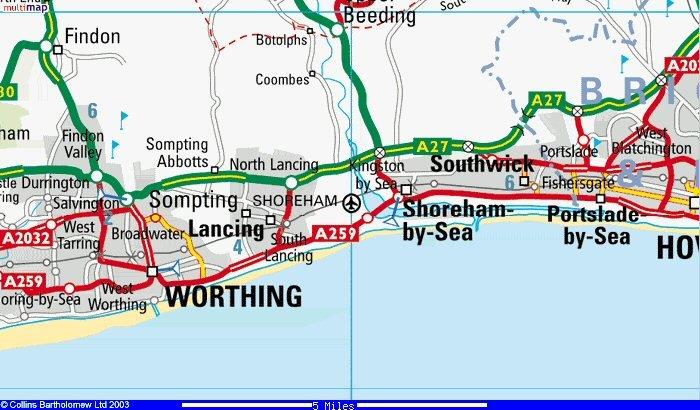
During the 1638 voyage from Hull to Boston there are indications that the "John" was captained by George Lamberton. The following excerpt from email received from Eric Lamberton (June, 2002):
"We are currently researching the background to the passengers on the ship "John" which departed Hull 1638. This ship was captained by George Lamberton (who settled at New Haven with John Davenport)....
George Lamberton took the settlers over to Boston where I believe he already had a house. There was some sort of dispute between him and the Rev. Ezekial Rogers. Lamberton, a seafarer trading down the eastern seaboard, wanted to join Davenport and go to New Haven (group of rich merchants, from London) He is listed on one of the best plots on the map of nine squares of New Haven. Just looking at the map, Rowley is slightly inland and would not have suited a sea captain. Edward Atwater in his History of the Colony of New Haven, mentions a minister of high standing in Yorkshire named Ezekiel Rogers who, having embarked at Hull on the Humber, with a company that personally knew him and desired to enjoy his ministry arrived in Boston late in the summer (in 1638). Rogers originally planned to join the colonists at Quinnipiac (New Haven) but something was not to his satisfaction (I don't know what) and he remained in Massachusetts Bay Colony. He established himself and his group at a place in Massachusetts that he called Rowley. Rogers frequently corresponded with Winthrop, the governor of Massachusetts Bay Colony. In one of his letters, he speaks of the New Haven planters as follows: "Sir: Mr. Lamberton did us much wrong. I expected his coming to the Bay: but it seems he sits down at Quinnipiac : yet he hath a house in Boston: I would humbly crave your advice to Mr. Will Bellingham about it, whether we might not enter an action against him and upon proof get help by that house." Atwater says, "This evidently refers to Rogers' disappointment in not receiving back those of his flock who staid in New Haven, and reads as if Lamberton were to be counted among them." (7)
So it would appear that our George was originally more associated with Rogers than he was with Davenport (?)"
There seems to be little doubt that George Lamberton was a seafarer and ships' captain, and that there was a close relationship (at least up until after Rogers' arrival in New England) between him and the Rev. Ezekiel Rogers. This suggests, I believe, that Lamberton was, indeed, the captain of the "John of London" on its voyage in 1638 that brought Rogers and his group from Yorkshire to Massachusetts.
NOTE: There is some interesting reading about the Rev. Rogers of Rowley in Atwater's History of the Colony of New Haven. The complete text can be found online at: http://www.quinnipiac.edu/other/abl/etext/colony/colonycomplete.html
As previously mentioned, there is no known record of the voyage of Rev. Ezekiel Rogers and his group to New England from Hull, Yorkshire in 1638 on the ship, “John of London”. However, the following chapter from Atwater’s History of the Colony of New Haven describes the preparations for and voyage of another group of Puritans in the year previous, 1637. This group, also led by a defrocked English vicar, John Davenport (the same Davenport as mentioned above), left London for Boston on the ship “Hector”, with Davenport and many others later settling in New Haven, Connecticut. While every voyage was certainly characterized by its own unique experiences, it can be assumed that there were also many similarities among voyages just a year apart. Therefore, the account of The Voyage Of The Hector most likely illustrates conditions, events and experiences similar to those encountered by those Puritans traveling across the Atlantic with the Rev. Rogers on the “John of London” in 1638. It should be noted that the account of "The Voyage of the Hector" is, itself, based on diaries kept by passengers on contemporary voyages.
I have been able to find no mention of the "John of London" after her 1638 voyage to Boston, until its demise in 1650:
"In 1650 the castle on the Bass was busy bombarding supply ships heading for Leith. One ship, the John o’ London was captured, looted and sunk. It contained Oliver Cromwell’s personal luggage. He was not amused and Proclamations "against Intercourse with the Garrison of the Bass" were posted on both sides of the Firth of Forth. Surrender of the Bass was demanded by the Deputy Governor of Leith on 22nd October 1651 to no effect. A setback occurred two days later when "the Lady and two brothers of the Governour of the Bass island" were captured and their estates sequestrated. Still, the Bass held out." (8)
Assuming that the above reference is to the same ship, the "John of London" was captured and sunk in the waters off Bass Rock, located at the mouth of the Firth of Forth on the east coast of Scotland. The port of Leith has since been absorbed as part of the city of Edinburgh and 1650 was the era of the English Civil Wars between Royalty and Parliament. Apparently the ship, like many galleons, had been refitted for war, and used by the Parliamentarians against King Charles II's supporters.
Map showing Bass Rock at the mouth of the Firth of Forth:

Bass Rock, a 300 foot high volcanic plug, offshore from ruins of Tantallon Castle: (9)

Summary:
Because of the lack of primary documentation, as well as the scarcity of secondary sources, much of the above discussion is based on speculation and conjecture by the author. With that in mind, we can summarize by saying that the ship, "John of London", a galleon, was probably built sometime durng the 1620's by Robert Trenckmore in his shipyards at Shoreham-By-Sea in England. The ship was captained by George Lamberton during its 1638 voyage from Hull, Yks. to Boston, Mass. At least once during its 20-30 year lifespan of plying the seas it was refitted as a fighting ship. It was captured and sunk near Bass Rock in the Firth of Forth, Scotland in 1650.
Map of England showing Shoreham-By Sea, Hull and Bass Rock:
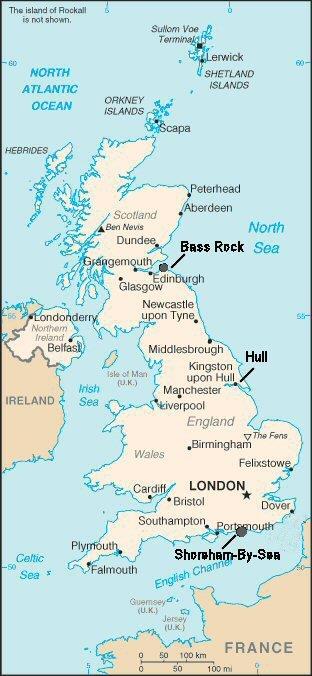
The author welcomes comments on this article and would be very appreciative of any and all additional information that anyone can and is willing to contribute for later revisions.
NOTES and REFERENCES:
(1) Ezekiel Rogers Window photo used with permission: webmaster, http://www.littleweighton.com;
(2) Paine, Lincoln P., Ships of the World, An Historical Encyclopedia; Houghton Mifflin Company, Boston, 1997. (p 619)
(3) http://en.wikipedia.org/wiki/Galleon
(4) Spectre, Peter H. and Larkin, David, Wooden Ship, Houghton Mifflin Company, Boston; 1991.
(5) Paine, Lincoln P., Ships of the World, An Historical Encyclopedia; Houghton Mifflin Company, Boston, 1997. (Centerpiece)
(6) Cheal, Henry, The Story of Shoreham, Hove Combridges, 1921. (pp 148-149)
(7) Atwater, Edward, History of the Colony of New Haven; 1880. (pp 84, 85)(http://www.quinnipiac.edu/other/abl/etext/colony/colonycomplete.html)
(8) Lauder-Frost, G.M.S., East Lothian Life, Issue 22, Autumn 1996, (ISSN 1361-7818).
(9) Bass Rock photo courtesy of T. L. Lipara.
Special thanks to Mark Andrew, Ken Burns, and Eric Lamberton for sharing much information and providing valuable assistance in researching this project.
R. A. Spafford
robert1056@aol.com
January 2005



